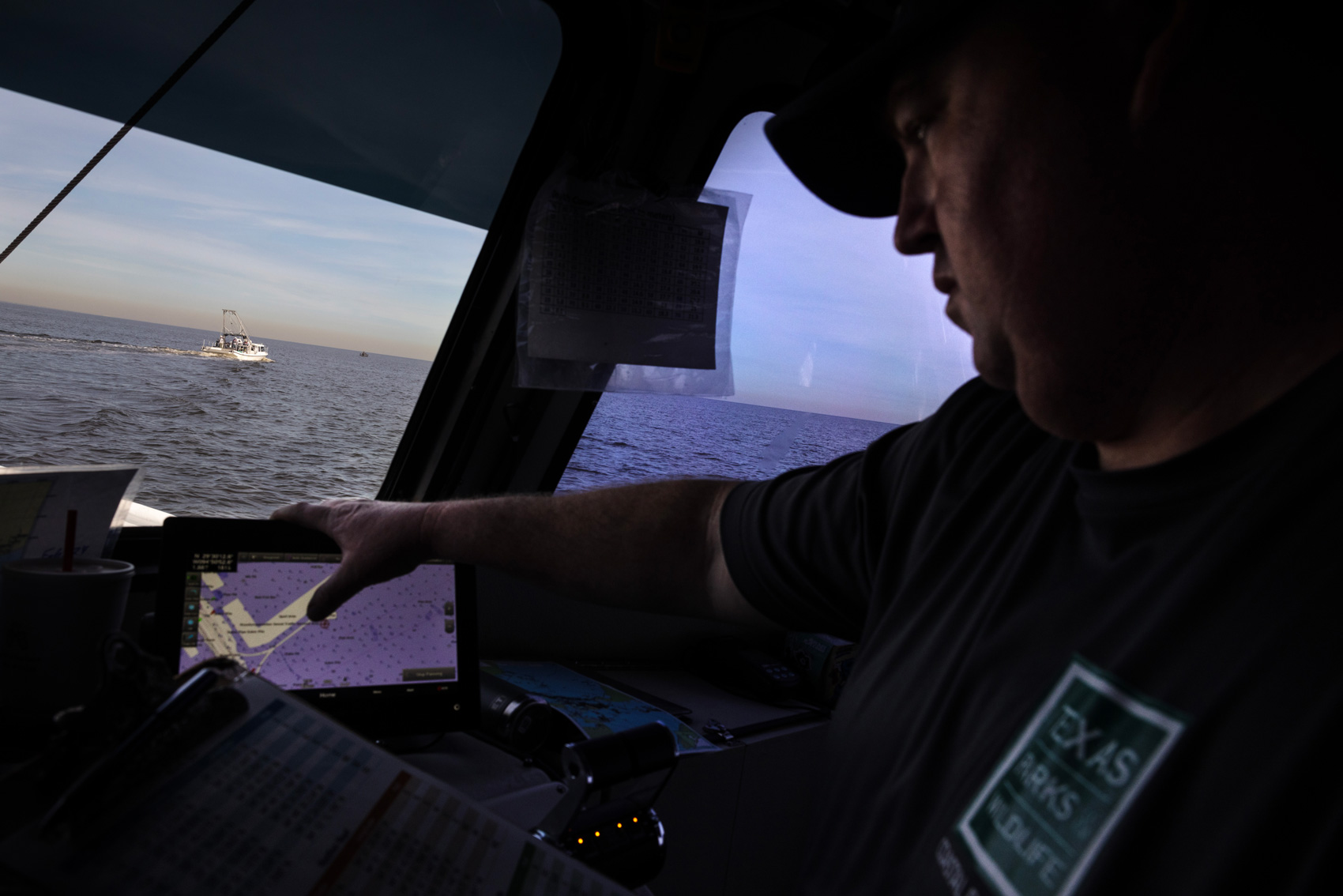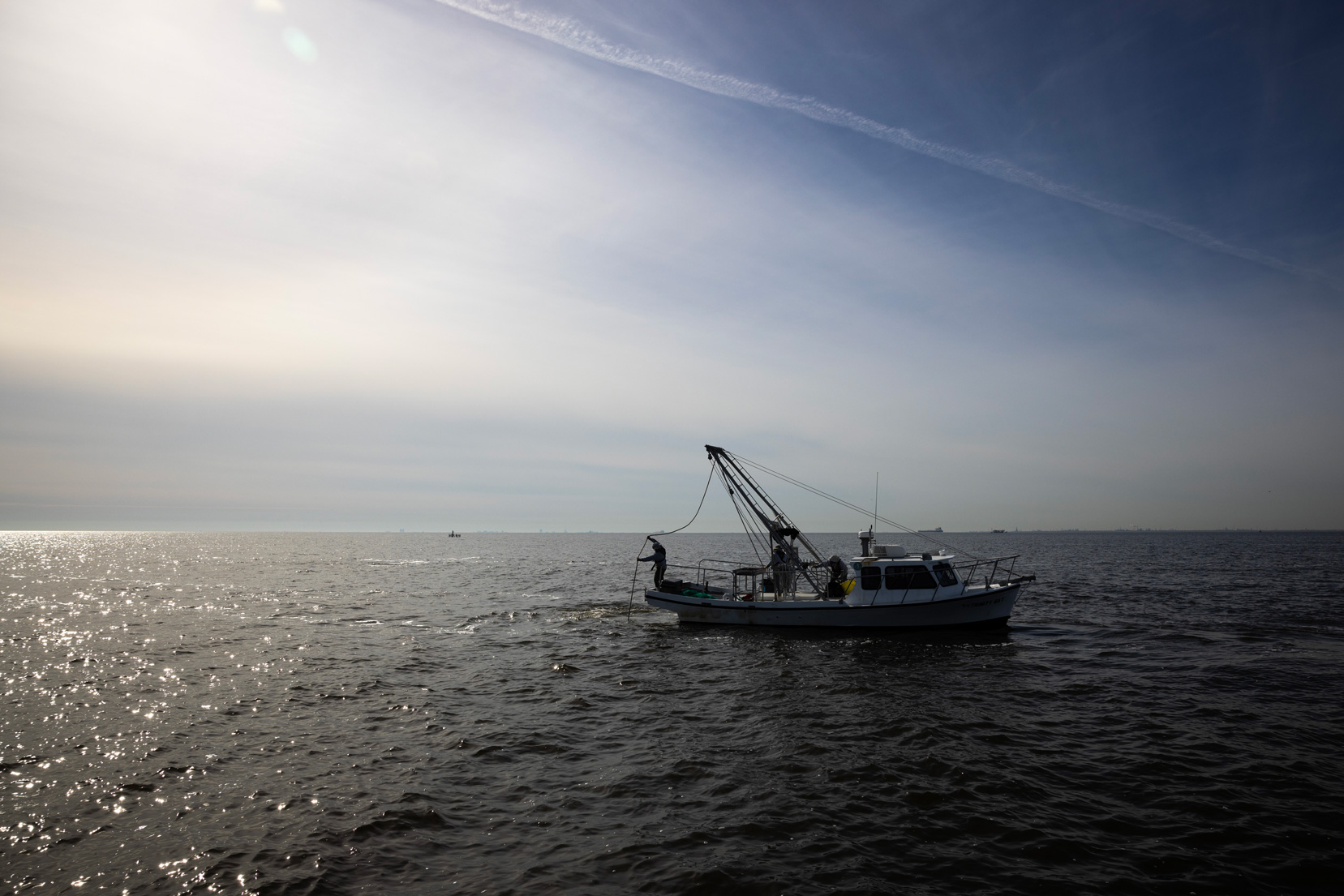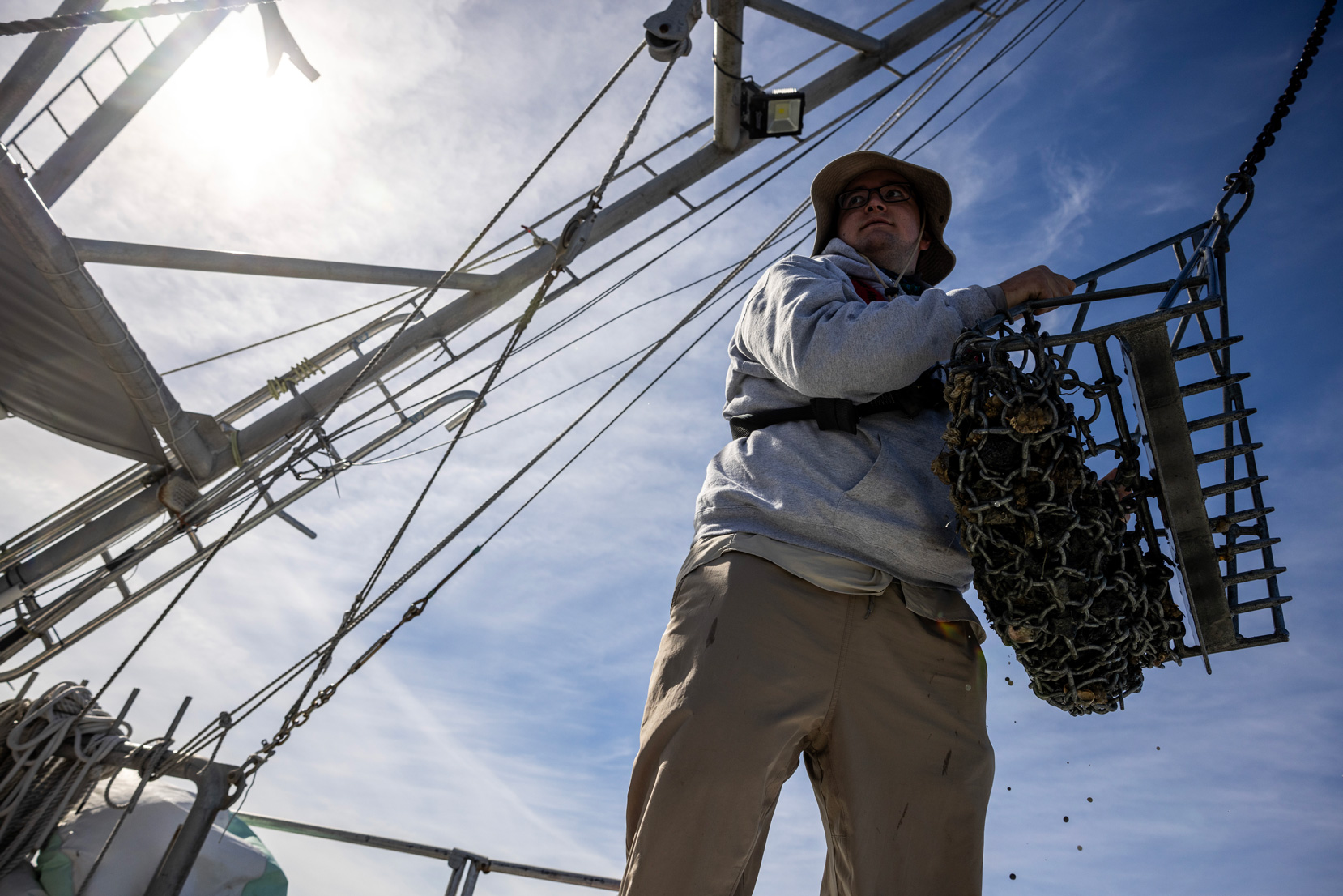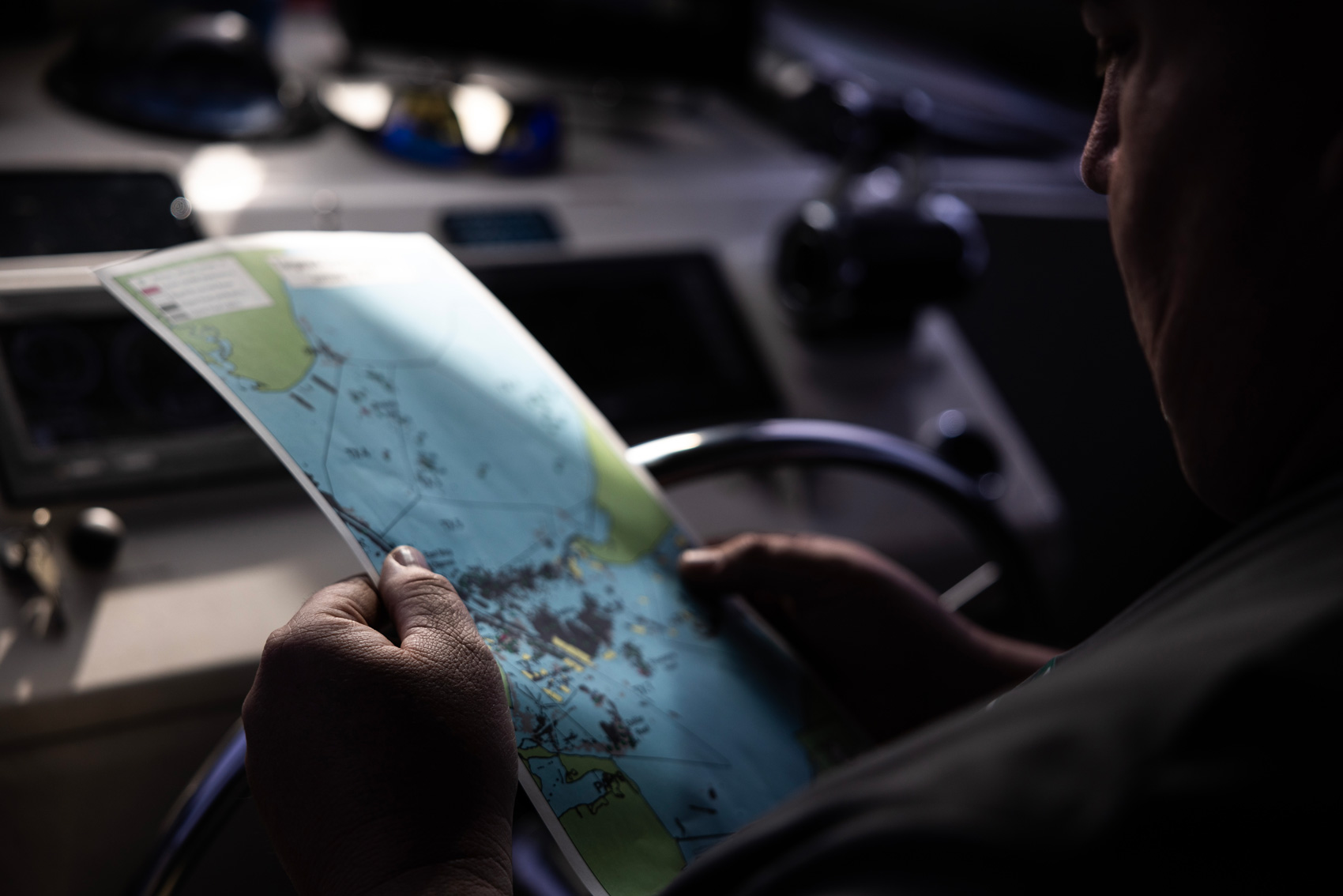|
Getting your Trinity Audio player ready...
|
On the swaying boat called the RV San Jacinto, Jessica Geiskopf is tossing aside black and dead oysters. Dark, silky mud leaks out of the shells, having suffocated the mollusks on the floor of Galveston Bay. They are discarded into a pile away from the healthy oysters.
It’s just after noon on a Tuesday in late January, and about ten miles from the Seabrook Marina and Shipyard outside Houston, Geiskopf is spending hours on the water surveying the oyster population. Over the course of the day, the Texas Parks and Wildlife Department biologist, along with three others, will count the number of oysters throughout the Redfish Reef.
The end results will determine if this particular section of Galveston Bay will open for commercial and recreational oyster harvesting again – a big deal for Houston and Galveston coastal oyster fishermen, suppliers and restaurants. The season, which spans from November through April, has been rough so far. Numbers are low, so spots for harvesting – such as Redfish Reef – have been closed since the start of the season.
Now, five months later, Geiskopf is checking on the numbers again.
The team is on the seventh of 10 catches they have to complete. For the survey, this means dredging, or dragging, a three-foot chained net along the bottom of the Bay for thirty seconds at 3 miles per hour and pulling up what they find.
If there are more blackened, dead shells than healthy brown shells, Geiskopf has to throw the batch back into the water and pull again – even if they find thriving, surviving oysters in the batch. The team can never stray from the methodology.


This seventh pull is particularly exhausting. Mark Krupp, a fish and wildlife tech with TPWD, looks over at Geiskopf, frustrated.
“Are you sure? This has been our best pull,” he said. There are about seven living oysters in the batch of 20.
She shakes her head. Krupp’s right to ask. It’s close, but there are too many dead ones. The pull has to be at least 50 percent healthy. They toss all the shells, alive and dead, back in the Bay. The team will have to dredge again.
“We have to be so careful with this work,” Geiskopf said. “Oysters in Houston are contentious. It’s a contentious issue. We could get taken to court over this, and if I show that I swayed the results, that’s a big problem. We have to follow our methodology to a T.”
This season, all the reefs in Galveston Bay are closed for harvesting. The count for marketable oysters, or oysters that are at least 3 inches in size, is too low for commercial or recreational oyster fishing – cutting off hundreds of local fishermen and large harvesting companies from making a living. This is because in the past few years, environmental factors and pressure from overharvesting has dropped the oyster count by as much as 85 percent globally, according to a 2018 report by the Nature Conservancy.
To address these concerns, in 2015 TPWD began to survey oyster populations at the numerous reefs in spots like Galveston Bay, Matagorda Bay and San Antonio Bay. If the number of market oysters caught per hour falls below 400, the site is shut down.
This management process will ostensibly save the population from dying out and keep areas viable for harvesting over time. However, critics of this process say this will only push fishermen to overharvest the remaining open spots.
Of the nine harvesting sites in Galveston Bay, the final two that were still operating closed in late November, just a few months after opening in September. But today, Geiskopf and the team are checking a different harvesting site – called Redfish Reef at oyster site TX-7 – to see if they can reopen it. It was September the last time they surveyed the spot. Still, after all this time, the catch is looking low.
Geiskopf wipes the inky, black mud off her hands from handling dead oysters. The team has been out since 9 a.m.. She takes a deep breath and adjusts her hat, getting ready to survey the next spot.
sCIENCE
HOW OYSTERS BENEFIT THE ECOSYSTEM

- Oysters provide a protected habitat for other marine species, such as fish and crabs, who hide in the nooks and crevices on the oyster.
- Oysters work as natural filtration systems. They can filter up to 50 gallons of water per day, removing algae and excess nutrients.
- In certain areas, oysters protect vegetation and coastal communities by stabilizing the reef from storms and waves.
Hurricanes and harvesting
Historically, Galveston Bay has been home to a robust and thriving oyster population.
Over time, however, increasing harvesting demands and environmental changes have put the oyster population in jeopardy. These issues especially came to a head after Hurricane Ike in 2008, when the storm buried more than 6,000 acres of oyster habitat beneath sediment, and then again after Hurricane Harvey, when heavy rains damaged the oyster’s ecosystem.
Hurricanes can disrupt the soil in oysters’ habitat, often leaving behind high nutrient levels and low oxygen levels – which can take months to bounce back to normal, all the while killing marine life at a higher rate. Burying the habitat under sediment after a hurricane also deprives the oysters of oxygen, suffocating them under the mud.
The large storms can shift the salinity level in the bays as well. The water in Galveston Bay needs to be at a perfect balance between freshwater and saltwater. When a hurricane hits the bay, a rush of saltwater can throw the bay’s balance off. Vice versa, rainfall and flooding from a hurricane can dump loads of freshwater into the bay, pulling in all types of pollution from the mainland and impacting oysters.

Climate extremes, such as stronger hurricanes or severe droughts, will continue to throw this balance off.
“Oysters are really resilient creatures,” said Kathy Sweezey, coastal restoration project manager for The Nature Conservancy in Texas. “They can tolerate a lot of salinity, but with saltwater can come all kinds of diseases that can kill off oysters.”
This season, the Texas Health Department has closed off several of the harvesting reefs due to freshwater inflow from recent coastal rainstorms. Oysters and other shellfish can naturally filter as much as 50 gallons of water every day. They remove excess nitrogen and contaminants from the water and return it clean. To do this, the oysters will accumulate the contaminants - making them inedible for human consumption.
“And that’s just the environment,” said Derek York, TPWD head fisheries technician and boat captain. “Harvesting is on top of all these issues.”
The Gulf Coast makes up for about 45 percent of the nation’s $250 million oyster industry, according to the National Oceanic and Atmospheric Administration. In Texas, commercial oyster fishermen can harvest up to thirty 110 lb bags of oysters per day. The industry adds up to about $43 million annually.
York, who has been with TPWD for the past 20 years, has seen a lot of changes in the oyster population, climate and harvesting rate. What hasn’t changed, however, is people’s devotion to the industry. In 2022, around 100 oyster harvesters and suppliers protested outside the TPWD offices in Dickinson, Texas over closures. Later on that same year, harvesters also protested at the Capitol in Austin.
“It’s turbulent to say the least,” York said. “It’s people’s livelihoods at the end of the day, but we have to keep going like this and if the numbers aren’t there, they aren’t there.”

Surveys and restoration
From the head of the boat, York honks the horn indicating that Jason Williams should release the dredging cage into Galveston Bay. York then begins to drive the boat ahead to drag the cage through the muck at the bottom. After thirty seconds, Williams pulls the cage up.
This is the third time for the seventh survey location. The second pull had just as many blackened and dead oysters as the first frustrating one. Williams, TPWD fish and wildlife tech, dumps the catch on the survey table.
“Oh, this is a good one,” Geiskopf exclaimed to the team – examining all the brown shells.
Williams, Krupp and Geiskopf begin measuring the oysters with small plastic rulers. They range from the baby oysters called spats to the largest market oysters. This round, there are 14 living market oysters – the best yet for the day. All the earlier catches had at most one living oyster.
Still, Geiskopf isn’t too impressed. If the reef was healthy, they’d be catching 60-plus market oysters per pull. This particular reef wasn’t doing too well, or at least not well enough. Two other boats of surveyors are out on TX-7, collecting data. Depending on what they pull, the parts of the area could reopen. Geiskopf is skeptical that would happen, but they won’t know for sure until all the results are taken back to TPWD for analysis.
And if TX-7 did reopen, it might have to close again due to the demand on the reefs.
A more long-term goal for the reefs is restoration, a generally expensive but effective way to restore the reefs and oyster population. In Galveston Bay, the National Fish and Wildlife Foundation awarded the Nature Conservancy, along with the Galveston Bay Foundation and TPWD, $2.5 million in 2019 to restore 40 acres of oyster reef habitat called Beezley Reef.
Unlike other sanctuaries on the Gulf, the acreage was designed to be split, with one part restricted from harvesting and another part for commercial fishing, according to Sweezey with The Nature Conservancy.
“We like to look at the full picture of oysters. They are just fantastic species that provide so many benefits to both people and the environment,” she said. “They filter water, they provide habitat for other marine species, but they’re also a big fishery here. Here, we can support the wildlife and the economy.”

Part one of the restoration project finished in 2021 and the other part completed in 2023. So far, Sweezey said the organization has seen results. In the protected part of the reef, the oysters are allowed to grow to larger sizes and reproduce baby spat, which in turn will travel over to the harvestable areas for the fishermen.
The hope is to eventually expand throughout all of Galveston Bay.
In the meantime, however, Geiskopf and the team will go out several times a month to check the oyster population at different bay locations – a never-ending task throughout the season. Even in the worst weather – waves, rain, and cold – they’re out there tossing black shells in the water and dragging a cage along the bottom of the bay.
At the end of the day, they have 46 market-sized oysters in total. Not a good look for the reef.
“Probably going to stay closed,” said Geiskopf. “But you never know.”
Correction, Feb. 7: An earlier version of this story misstated the threshold the number of market oysters caught per hour must fall below for the site to be shut down. It is 400, not 1,100. This story has also been updated to accurately reflect oyster season.






